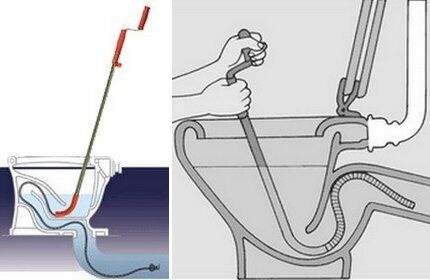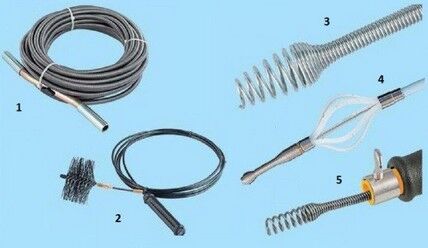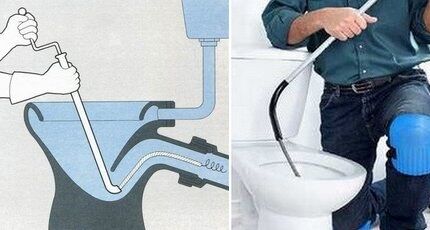How to clean a toilet with a cable: choosing a tool and instructions on its use
Blockages are a common problem.It is the scourge not only of cast iron pipelines, but also of modern plastic pipelines and carefully thought out plumbing fixtures. The most effective way to combat sewer congestion is a plumbing cable. But they need to be used skillfully. Do you agree?
The article presented for your review describes in detail how to choose this type of plumbing tool for breaking a blockage. We will tell you what you should pay attention to when choosing it for work. You will learn how to clean a toilet with a cable, what preventive measures should be taken in order to use it as little as possible.
The content of the article:
Causes of blockages
The choice of the type of tool and method of eliminating the problem depends on what type of blockage you have to deal with.

There are three types of blockages:
- Operational. It occurs due to the ingress of organic and household waste into the system, for example: food debris, grease, sand, wool and hair. Plaques and deposits formed on the walls narrow the diameter of the passage opening, preventing the normal passage of water.
- Mechanical. Occurs when generally accepted rules for operating the sewer system are violated. For example, due to carelessness or ignorance, large garbage is thrown into the toilet. It interferes with wastewater, forming a dense blockage.
- Technological. It occurs as a result of a violation of the installation technology of the communication system or due to its wear and tear.
Plugs of an operational nature are easily handled by the simplest rope-type cables, 5-6 meters long and 6 mm and 9 mm in diameter. Simple mechanical blockages help eliminate spring-wound cables.
Technological type blockages cannot be eliminated using a cable. Correcting a defect by solving a problem can only be done by complete pipe replacement.
Main types of plumbing cables
The plumbing cable used for cleaning is a flexible shaft that performs the function of transmitting torque. The tool is used not only for “punching” sewer pipes, but also for cleaning water supply lines, as well as treating the inside of boiler and boiler pipes.

The tip performs two functions:
- holds replaceable tools that can be used to facilitate the cleaning process;
- prevents self-unraveling of the cable, thereby extending the service life of the product.
The cable structure is represented by a rod or shaft, the central part of which is equipped with a core. Wire strands are wound around the core in several layers in different directions.
The direction of the strands of each layer alternates: the first layer is laid to the right relative to the axis, the second - to the left. When manufacturing the core, the number of layers of strands is repeated until a certain shaft diameter, specified by technological standards, is reached.

In addition to the main function - clearing blockages in the water supply and sewerage systems, cables are often used to remove blockages in boilers and boilers, as well as to clear soot from chimneys.
There are three main types of tools on sale: rope, spring-wound and spring.
It should be remembered that when cleaning with a cable, earthenware plumbing can be seriously damaged. In order not to lead the situation to the need for mechanical destruction of the blockage, the following preventive measures are recommended:
Rope type device
The rigging cable is used to clean small clogged sections of the pipeline inside the apartment. It is made of galvanized durable steel, which is famous for its high strength and durability. Rope-type products are traditionally made with a diameter of 6 mm, due to which they are flexible and resilient.

The end of rope-type products is crimped with a tip to prevent unraveling of the wire threads.To make it easier to remove hairballs from the pipeline, manufacturers give the tip a fluffy brush shape.
To clean the plumbing inside the apartment, rigging cables with a length of 2.5 to 5 meters are used. It is not advisable to purchase longer products, since the main line rarely exceeds a length of 5 meters.
Spring-wound cable
A spring-wound cable is a more rigid product, the diametrical cross-section of which is at least 9 mm. It is chosen for cleaning toilets, as well as indoor water and sewer pipes.

This cable is equipped with a rotating handle, which has a curved shaft design. The device ends with a bend or tip, with the help of which it is easily moved into the cavity of the pipe. Devices of this type for domestic use are not equipped with special attachments.
Thanks to the excellent elasticity of the tool, despite the sufficient rigidity of the structure, the cable easily copes with all difficult obstacles in its path.
Spring spiral with tensioner
The spring cable belongs to the category of professional equipment. It is used by plumbers to break through serious, complex blockages in both horizontal pipes and vertical risers. The diametric size of products varies in the range of 13.5-16 mm. The length can reach from 25-60 meters.
Small-diameter products are used for cleaning toilets, urinals and sewer pipes in public places.A large-section spring with increased rigidity is used when it is necessary to remove blockages from sewer risers passing through interfloor ceilings

As the diameter of the cable increases, the size of the wire used for its manufacture also increases:
- for products with a thickness of 10-12 mm, use a metal cord D 1.4 mm;
- for 14 mm cables – thread D 1.4 mm;
- for rods D 16 mm - wire D 2.1 mm.
Spring-type products, like their simpler analogues described above, are equipped with a handle. But in models of this type it serves as a tensioner. At the moment of rotation and tension, the spring acquires special rigidity, thanks to which it easily destroys even the most complex blockages.
In professional models, used for pipes long, the handles are often made sliding. Due to this, they easily move along the length of the rod and are fixed in the desired position. This design solution allows you to avoid coiling the cable during operation.
Depending on the model, the equipment may be equipped with various types of attachments.
They are selected based on three parameters:
- pipe type;
- material of their manufacture;
- design features (presence of joints and elbows).
To break through crumbs of stone and sand, use a bottom nozzle; to remove compressed blockages, use a punching tip; and to remove lumps of dirt and old rags, use nozzles in the form of loops and hooks.
Tool selection criteria
When choosing a product, you need to touch and inspect it for mechanical damage.The cable should not have any bending memory. Make sure the handle is securely fastened. Pay attention to the pipe. It should be a little springy and plastic.
All elements of the tool, including nozzles intended for impact, must be made only of high quality steel.
The main parameters that should be considered when choosing a plumbing cable:
- Device diameter. The size of plumbing cables available for sale ranges from 6-18 mm. The required size of the rods is selected based on the diameter of the laid pipes and the complexity of the blockage.
- Design. The handle can be L- or Z-shaped. Handles equipped with a locking system are available on sale. They are convenient because they hold the rods and at the same time allow them to be rotated in any direction.
- Complete set of replaceable nozzles. Among the variety of replaceable nozzles on the market, the most popular are “harpoons”, with the help of which it is convenient to remove large elements of dense plugs, and reinforced punches, capable of breaking through the hardest blockages.
To work with sewer and drain pipes D 100 mm made of plastic, rods with a diameter of 10-12 mm are selected. Models of this size are also irreplaceable if the pipeline includes a large number of turns with an angle of over 45°.
If it is necessary to work with sewer pipes D 100-200 mm, which have a large length, choose tools D 14 mm. For pipes D 200 mm or more, tools with a diameter of 16 mm are used.

Important point! If the first and last layers of the core are wound to the right along the axis, then this indicates that the cable is designed for right-hand rotation. In this direction the tool has 2 layers of wires more than in the left direction. And if you rotate the cable to the left, it will simply break.
If possible, you can purchase an electric cable.

“Turnables” are able to quickly and effectively remove simple blockages on short and medium distances of sewer routes.
Rope Application Guide
Clearing clogged water and sewer pipes using a cable involves a number of main steps.
Detailed methods cleaning the toilet with a cable are described in the article, which we recommend that you read. Practice-tested techniques will help you quickly resolve the problem.
Step 1. Carrying out preparatory work
It is better to carry out cleaning operations when the first signs of communication obstruction are detected. You shouldn’t wait until a small blockage thickens and turns into an impenetrable plug.

Having determined the type of blockage that has formed and its location, prepare a tool with appropriate attachments to eliminate the problem.
The first stage involves preparing the cable for operation. To do this, the instrument is inspected for integrity and performance.On the cable itself, it is necessary to check the strength and reliability of the handle.
Before starting work, the floor must be covered with film. It is recommended to carry out further manipulations wearing protective gloves.
Step #2. Cleaning clogged areas
To ensure high quality clean the drain, it is necessary to open free access to the outlet pipe socket. To do this, the first thing you need to do is remove the siphon. It has the shape of a curved pipe and is attached to the drain hole.

The sequence of actions when working with the tool:
- Holding the rotary handle in the palm of your hand and fixing the main part of the cable in a coiled position in the shape of a ring, the working end of the tool is inserted into the hole in the pipe.
- By making translational and rotational movements with the handle, they move the device deeper into the pipe and overcome difficult areas. The cable itself must be unrolled only to the length required to clear the blockage.
- Having reached the blockage, rotate the handle to increase the force and increase the speed of movement, trying to destroy the seal.
There are two ways to remove a dirt plug: by pushing it forward, after putting on a punch of a suitable size, or by removing it using a hook-hook. When making translational movements, you should not press the tool with force. This can damage the equipment and ruin the inside surface of the smooth plastic pipe.

When guiding the cable and imparting torque to it, rotational movements must be performed only in the direction of clockwise movement. If you rotate the handle of the tool in the opposite direction, you can cause the flexible core to unravel.
During the process of passing obstacles, you periodically need to pull the cable to the surface and clean it from any remaining adhering dirt. It is better to do the work together, dividing the responsibilities of rotating and pushing, alternating with cleaning the tool nozzle.
Step #3. System health check
Noticing that the accumulated liquid begins to leave, empty the tank or open the hot water tap. At first, it is better to supply water at low pressure. If everything goes smoothly, you can gradually increase the flow strength.

There are situations when the cable gets stuck in the pipe during rotation. In this case, the easiest way to solve the problem is to turn the tool left or right and apply light pressure.
General rules for caring for the device
The cable, like any other plumbing fixture, needs proper care. After each use, the instrument must be washed under pressure of water or in a filled container with the addition of a soap solution.
To avoid rust between the wire layers, the spring part of the tool must be regularly treated with machine oil.
In the future, if it is necessary to shorten the cable, the cut site will need to be pre-annealed by 10-12 cm.

The oil-treated cable is wiped dry with a piece of cotton cloth and rolled into a coil. In this position, it takes up minimal space, making it easy to place it in a corner under the bathroom or in a cabinet among tools. With proper care, such equipment can serve its owner well for more than two decades.
All options for tools used in toilet cleaning, are given here. It is possible that they will help if you do not have a cable at your disposal, and you need to clear the jam urgently.
Conclusions and useful video on the topic
Review of improved types of plumbing cables:
And finally, advice from the master. When cleaning, to soften the blockage and make it easier to move the tool, if possible, pour portions of hot water into the pipe. Otherwise, the procedure for cleaning a sewer using a cable should not cause any particular difficulties.
Please write comments in the block form below. Tell us about how you cleaned your own toilet with a cable, ask questions, and share useful information on the topic. Perhaps you have in your arsenal an original method of breaking a jam that is not discussed in the article.




My son is in school and his friends come to visit him. One boy, out of spite, threw a cabbage stalk into our toilet. At first I didn’t know what happened, why there was a blockage in the toilet. Then they told me.No matter how I tried with a plunger, nothing worked. Replacing a toilet is expensive! It's good that I found this site and looked at your advice. I bought the cable and cleaned it myself. Thank you very much!
With the help of a cable, pipes, a toilet, and anything else can be cleaned well. The main thing is that this is done very simply, there are no tricks here. I have the simplest rope type cable. The only thing that makes it a little inconvenient is the length. But if you clean not alone, but with an assistant, then everything is done easily and simply. Moreover, the assistant can be a wife or child, there is no need to put in much physical effort, the assistant simply turns the cable, and you push the cable into the pipe to the place of the blockage. You can do all this alone, but it is more difficult.
My husband always cleans the drain himself using a cable. And he always succeeds. There is no need to call plumbers, and even pay them for it. The main thing is to avoid complete blockage, when it will be very difficult to do anything. As soon as you discover that there is the slightest blockage, you need to immediately clean the toilet. You also need to pour a lot of water, preferably hot, so that debris and dirt pass faster.
Everything is so simple “in the picture” and when you come across it - only positive comments.